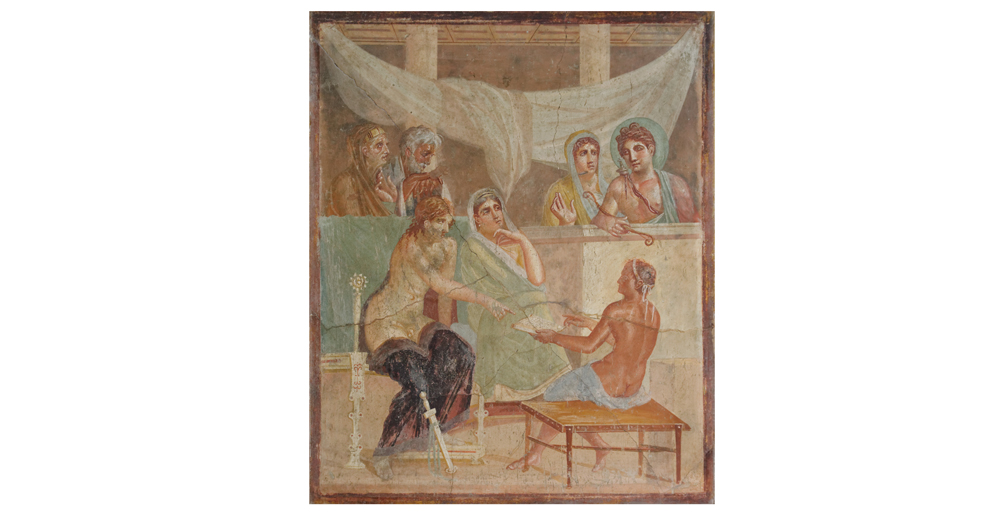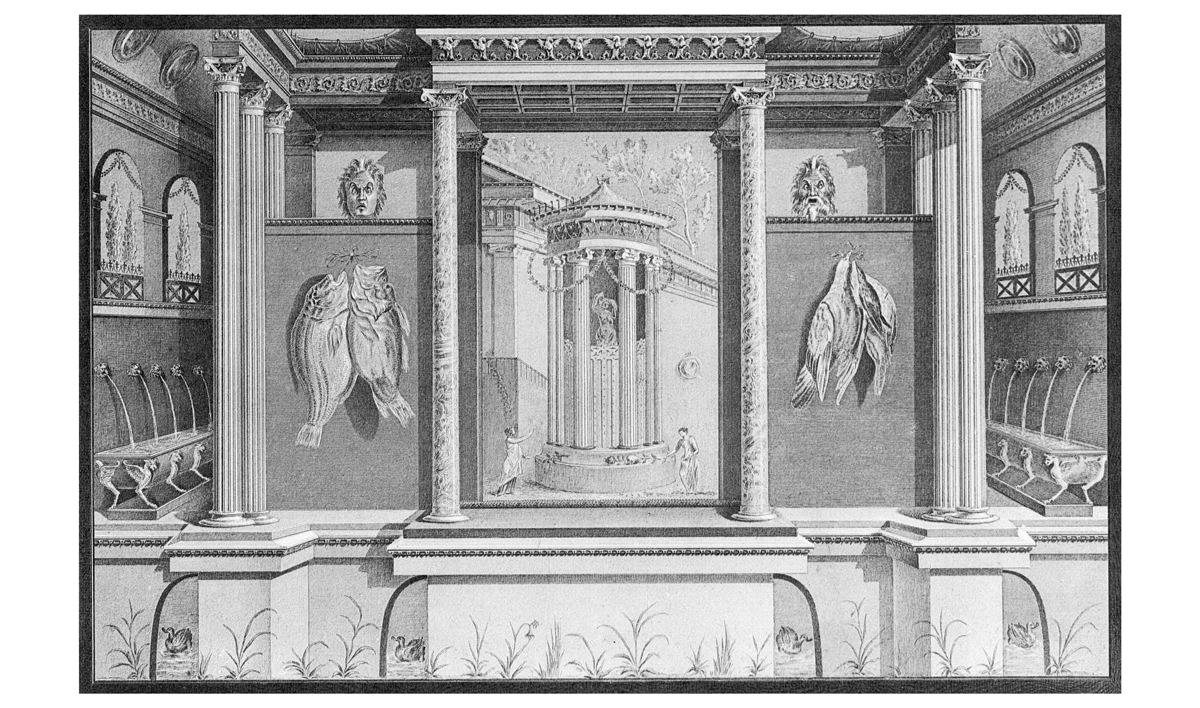Johanna Fabricius aimed in this research project at developing an explanatory model for the representations of spatial objects and perspectival configurations within complex two-dimensional compositions in Greek and Roman pictorial art, i.e. vase paintings, mosaics, wall paintings, and reliefs.
Thanasis Georgakopoulos together with Johanna Fabricius investigated the different meanings associated with body part lexemes in Ancient Greek and Latin and analysed the underlying motivations for the observed associations. Greek and Roman art was taken into account for certain semantic connections in the semantic domain of body parts.
Research
Johanna Fabricius took as a starting point the current discussion on perspective(s), perspectivity and perspectivation which has stimulated different disciplines in cultural studies for several years (i.e. cognitive linguistics, discourse linguistics, narratology, philosophy, art history).
It has often been stated by ancient art historians, though not unanimously, that Graeco-Roman conventions of representing pictorial space followed their own rules and therefore cannot be parallelised with Renaissance linear perspective. However, traditional analyses of such pictures, informed by reception aesthetics, and asking for compositional principles and spatial relations between beholder and picture, between viewpoint, figures and background and between diverging directions of viewing and action, also do not provide clear results, a fact that has yet to gain sufficient attention. Therefore, alternative models had to be established.
Results
By introducing concepts of cognitive science into the discussion – especially theories from cognitive linguistics – the project suggested that different cognitive styles could be expected in the respective cultural settings of ancient societies, which had consequences for every day spatial experiences as well as for artistic representations. This hypothesis has been verified in several case studies.
For example, in Greek vase painting from the 5th century onwards, cubic objects were depicted in oblique axonometry particularly when their supporting character was to be emphasised. A continuation of the connotations of a similar pictorial formula can be observed in Roman wall painting. Mythical figures often sit on cubes and pieces of furniture depicted in oblique view which are now shown from above and in inverted perspective, no longer in parallel perspective. These seats with their inverted orthogonals seem to transform the Greek exemplars, but despite the changes in the perspective system the semantic qualities of the cubic objects remain the same and – above all – do not depend on an implicit beholder.

Admet and Alkestis: Fresco, Casa di Poeta tragico in Pompeji, 1st century AD, Naples Archaeological Museum, inv. 9026 | Photo: Marie-Lan Nguyen, Public Domain
This convention is even more common and concise in the depiction of throne scenes: Enthroned figures of rulers, seen frontally or obliquely, often show a platform or footstool depicted in inverted perspective, a tradition which can be observed even later in Byzantine and Medieval art. The expressive content of ‘stability’ and ‘support’ may also explain why from the second style onwards the upper zones of the angulated Pompeian wall systems have their vanishing point or vanishing axis more or less consistently in the middle, while the lower zones only partly follow this logic, and especially column pedestals are rendered in inverted perspective.
A genealogical approach also helps to understand the long-lasting pictorial convention of representing the frontal part of the ground in pictorial scenes. It can be observed that the irregularly shaped baseline of late classical paintings and mosaics, which resembled rock formations, had been transformed since the 3rd century BC into a geometrical step-shaped edge or strip, to indicate the stable qualities of the ground. Even on Roman two-dimensional paintings the surface on which figures and objects are positioned often has the form of a platform or stage with a differently coloured frontal edge.

Wall system in the second style from house VI, 17, 41 in Pompeji (c. 40 BCE) after the reconstruction by A. Sikkard. Reproduction after A. Mau. Geschichte der decorativen Wandmalerei in Pompeji. Berlin: Reimer, 1882, plate 7b
The research within this project provided a historically more adequate image of Greek and Roman art which can contribute to more considerate interpretations of continuities and shifts within these periods. The suggested interpretation foregrounds semantic qualities and cognitive categories instead of optical effects. In particular, the persistent pictorial traditions give us information about the cognitive concepts of specific spatial elements rather than about pictorial space understood as an overarching coherent system.
Further research
Situated within the tradition of the cognitively oriented approaches to semantics, Thanasis Georgakopoulos and Johanna Fabricius investigated body part terms and the different meanings associated with them as this has been one of the most intriguing subjects within the conceptual metaphor theory paradigm. This line of research is usually linked to the general embodiment hypothesis, which assumes that the human body intervenes decisively in word meaning (e.g., George Lakoff 1987). In this research project the English equivalents of the terms eye, face, foot, hand, head, leg, and mouth were being analyzed. The data were extracted from dictionaries and the Perseus digital library focusing on Classical Latin (1st century BC – 1st century AD) and on Ancient Greek (8th – 4th century BC).
Results
1. Semantic extensions of Ancient Greek and Latin body parts could — by and large — be described with respect to extant taxonomies. However, it is argued that the notion of domain should also capture extensions that occur within the same semantic domain.
2. Latin and Greek converge in various levels. For example, both associate the eye with plants, in which case the metaphorical motivation along the lines of plants are humans can be suggested (cf. Martin Hilpert 2007).
3. The same motivation leads to both convergence and divergence, as happens with the dimension of spatial contiguity which triggers different polysemies among body part terms (cf. Soteria Svorou 1994). For instance, anatomical adjacency between the face and the mouth motivates the face-mouth polysemy in Latin, but not in Greek (Lat. ōs vs. Gk. stóma), whereas spatial contiguity between face and eye triggers the face-eye polysemy in Greek, but not in Latin (Gk. ōps vs. Lat. oculus). As the variation between the languages suggests, spatial contiguity is not a sufficient factor for polysemy to emerge. For example, it can – partially – explain why the meanings “face” and “mouth” are connected in Latin, but cannot capture the absence of this polysemy in Greek. If the value the concept mouth had in Roman and Greek culture is compared, a more holistic explanation can be provided. Romans, in contrast to Greeks, considered the mouth as the most prevalent part of the head. It has been suggested that the cultural importance of mouth can be linked to the central role of the orator for Romans (cf. Maurizio Bettini 2011, Johanna Fabricius 2007). In the case of the Latin lexeme, the human mouth stands for the whole face because of its relationship with oratio and orator. Indirect linguistic evidence also suggests that in Latin, knowledge is mainly connected to the mouth, whereas in Greek to the eye. Taken together, these findings indicate that culture is a key player in motivating paths of semantic extension.
4. The cultural significance of the eye and the mouth for Greeks and Romans respectively is also indirectly mirrored in works of art (cf. Françoise Frontisi-Ducroux 1995, Johanna Fabricius 2007). For example, the controlled appearance in people’s assemblies and the avoidance of mimic was an ideal pattern, which was more expected for speakers in Classical Athens than in Rome. Maybe through such social practices the eye and the mouth obtained a different content in these cultures as comparisons with cultures in Eastern Asia suggest (cf. Masaki Yuki, William W. Maddux, and Takahiko Masuda 2007).
Results of the project have been presented not only at various conferences but also published in:
